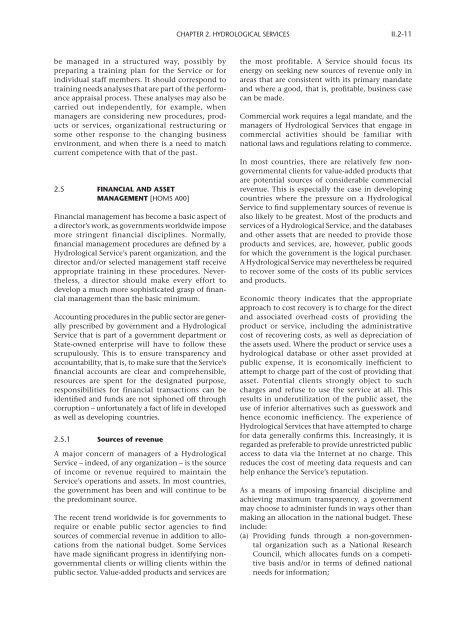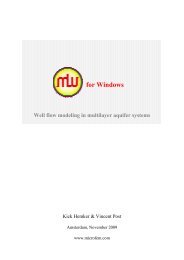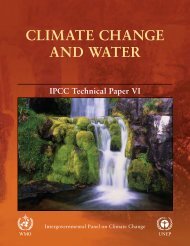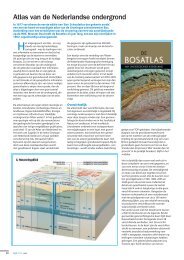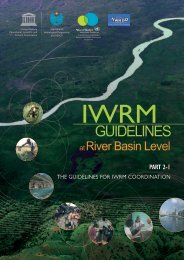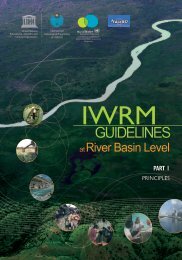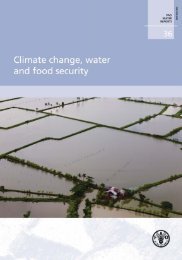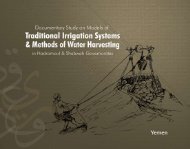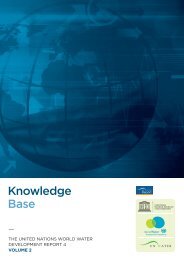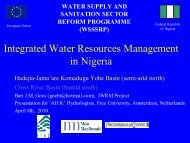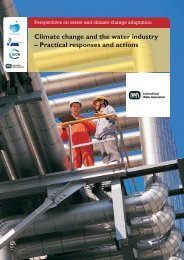Guide to Hydrological Practices, 6th edition, Volume II - Hydrology.nl
Guide to Hydrological Practices, 6th edition, Volume II - Hydrology.nl
Guide to Hydrological Practices, 6th edition, Volume II - Hydrology.nl
Create successful ePaper yourself
Turn your PDF publications into a flip-book with our unique Google optimized e-Paper software.
CHAPTER 2. HYDROLOGICAL SERVICES<strong>II</strong>.2-11be managed in a structured way, possibly bypreparing a training plan for the Service or forindividual staff members. It should correspond <strong>to</strong>training needs analyses that are part of the performanceappraisal process. These analyses may also becarried out independently, for example, whenmanagers are considering new procedures, productsor services, organizational restructuring orsome other response <strong>to</strong> the changing businessenvironment, and when there is a need <strong>to</strong> matchcurrent competence with that of the past.2.5 FINANCIAL AND ASSETMANAGEMENT [HOMS A00]Financial management has become a basic aspect ofa direc<strong>to</strong>r’s work, as governments worldwide imposemore stringent financial disciplines. Normally,financial management procedures are defined by a<strong>Hydrological</strong> Service’s parent organization, and thedirec<strong>to</strong>r and/or selected management staff receiveappropriate training in these procedures. Nevertheless,a direc<strong>to</strong>r should make every effort <strong>to</strong>develop a much more sophisticated grasp of financialmanagement than the basic minimum.Accounting procedures in the public sec<strong>to</strong>r are generallyprescribed by government and a <strong>Hydrological</strong>Service that is part of a government department orState-owned enterprise will have <strong>to</strong> follow thesescrupulously. This is <strong>to</strong> ensure transparency andaccountability, that is, <strong>to</strong> make sure that the Service’sfinancial accounts are clear and comprehensible,resources are spent for the designated purpose,responsibilities for financial transactions can beidentified and funds are not siphoned off throughcorruption – unfortunately a fact of life in developedas well as developing countries.2.5.1 Sources of revenueA major concern of managers of a <strong>Hydrological</strong>Service – indeed, of any organization – is the sourceof income or revenue required <strong>to</strong> maintain theService’s operations and assets. In most countries,the government has been and will continue <strong>to</strong> bethe predominant source.The recent trend worldwide is for governments <strong>to</strong>require or enable public sec<strong>to</strong>r agencies <strong>to</strong> findsources of commercial revenue in addition <strong>to</strong> allocationsfrom the national budget. Some Serviceshave made significant progress in identifying nongovernmentalclients or willing clients within thepublic sec<strong>to</strong>r. Value-added products and services arethe most profitable. A Service should focus itsenergy on seeking new sources of revenue o<strong>nl</strong>y inareas that are consistent with its primary mandateand where a good, that is, profitable, business casecan be made.Commercial work requires a legal mandate, and themanagers of <strong>Hydrological</strong> Services that engage incommercial activities should be familiar withnational laws and regulations relating <strong>to</strong> commerce.In most countries, there are relatively few nongovernmentalclients for value-added products thatare potential sources of considerable commercialrevenue. This is especially the case in developingcountries where the pressure on a <strong>Hydrological</strong>Service <strong>to</strong> find supplementary sources of revenue isalso likely <strong>to</strong> be greatest. Most of the products andservices of a <strong>Hydrological</strong> Service, and the databasesand other assets that are needed <strong>to</strong> provide thoseproducts and services, are, however, public goodsfor which the government is the logical purchaser.A <strong>Hydrological</strong> Service may nevertheless be required<strong>to</strong> recover some of the costs of its public servicesand products.Economic theory indicates that the appropriateapproach <strong>to</strong> cost recovery is <strong>to</strong> charge for the directand associated overhead costs of providing theproduct or service, including the administrativecost of recovering costs, as well as depreciation ofthe assets used. Where the product or service uses ahydrological database or other asset provided atpublic expense, it is economically inefficient <strong>to</strong>attempt <strong>to</strong> charge part of the cost of providing thatasset. Potential clients strongly object <strong>to</strong> suchcharges and refuse <strong>to</strong> use the service at all. Thisresults in underutilization of the public asset, theuse of inferior alternatives such as guesswork andhence economic inefficiency. The experience of<strong>Hydrological</strong> Services that have attempted <strong>to</strong> chargefor data generally confirms this. Increasingly, it isregarded as preferable <strong>to</strong> provide unrestricted publicaccess <strong>to</strong> data via the Internet at no charge. Thisreduces the cost of meeting data requests and canhelp enhance the Service’s reputation.As a means of imposing financial discipline andachieving maximum transparency, a governmentmay choose <strong>to</strong> administer funds in ways other thanmaking an allocation in the national budget. Theseinclude:(a) Providing funds through a non-governmentalorganization such as a National ResearchCouncil, which allocates funds on a competitivebasis and/or in terms of defined nationalneeds for information;


